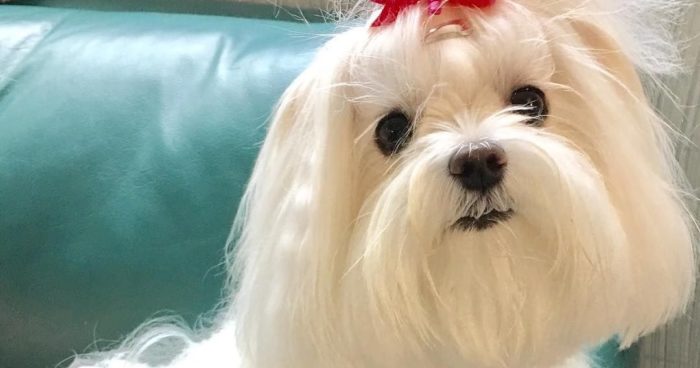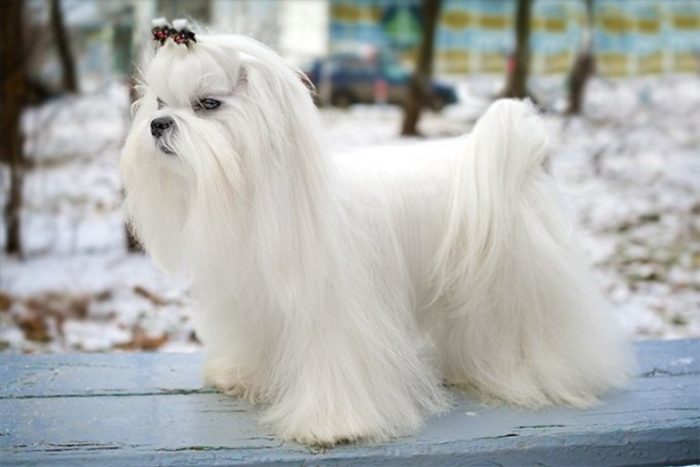The Maltese pup is one canine breed that deserves the top spot on the list of the cutest dog breeds in the world. Its long fluffy white or tan coat that almost sweeps the ground gives the pup the best distinguishing feature and together with that buoyant, flowing gait, the canine is comparable to an adorable stuffed animal but in flesh and blood. This quintessential lap dog will make a perfect family pet, albeit, extreme care should be taken in households with little children. The Maltese can also co-habit with other household pets, all you need is early socialization and training.
Table of Contents
Origin of Maltese Dog Breed
The origin of the Maltese dog breed is traceable to the island of Malta in the Mediterranean region. No one knows when the breed came into existence but it has been around for thousands of years. The great philosopher, Aristotle once admired the breed and some prehistoric Greek pottery carried the images of the Maltese dog.
Roman aristocrats were known to adopt the breed just to keep them as status symbols. These petite dogs usually accompany their master wherever he goes.
The fall and end of the Roman Empire marked a reduction in the number of Maltese in the world. However, it is thanks to the Chinese that the bloodline is still in existence today, these Asians kept the Maltese breed alive and later refined it by crossing with some of their toy breeds.
The breed was first recognized by The American Kennel Club AKC) in 1888, and its popularity has continued to grow to date.
Important Things To Know About the Maltese
- Group: toy
- Height: 7 to 9 inches
- Weight: under 7 pounds
- Coat: long, silky
- Coat color: white, black points
- Life span: 12 to 15 years
- Temperament: affectionate, alert, fearless
- Hypoallergenic: yes
- Origin: malta/Mediterranean region
- Tendency to Bark: Medium
- Amount of Shedding: Low
Appearance

A quintessential lap dog, at the puppy stage, the Maltese breed’s fluffy white or tan fur, dark eyes, adorable black-button nose, and sprightly demeanor give it the appearance of a little stuffed animal.
Compact body, sloping shoulder blade, level back, and well-sprung rib are some of the features that distinguish this toy breed that can only grow up to 7 to 9 inches and never exceeds seven pounds in body mass. The Maltese dog breed carries its tail gracefully over its back. That slightly rounded skull, well-proportioned with its body is carried on an elegantly structured neck.
Heavily feathered low-set drop ears are part of the breed’s identity, including a medium-length muzzle that is slightly tapered.
The dog’s signature ornamental appearance is thanks to that long, silky coat that either hangs close to the ground or sweeps it. That buoyant, flowing gait is another unique factor that is sure to grab all attention at any dog show.
Health
With their life span averaging 12 to 15 years, the Maltese dog breed is generally healthy, however, owners should know that it is a fragile dog and shouldn’t allow it to engage in high jumps that may result in injuries.
With that said, the breed is prone to some health conditions such as dental problems, luxated patellas (knee problems), and Legge-Calve-Perthes Disease (LCPD) (hip problems)
Training
The Maltese breed is an eager-to-please dog that may prove difficult to train, thus, the experts recommend crate training. The dog is a master at getting whatever it wants, an act it perfected from living in close quarters with humans for centuries; this makes them headstrong and calls for early socialization and training. Always introduce treats and positive reinforcements into your training sessions and your furbaby will respond fairly well.
- Socialization and training should commence at the puppy stage
- Enrolling your Maltese in an obedience class is a good idea
- Expose the pup to other animals, people, and situations
Instill good manners, confidence, and comfort in your canine friend as they tend to be overly protective when they are around strangers and in strange situations; this may result in excessive barking or nipping.
Guard against separation anxiety by not leaving the dog home alone for too long; this leads to destructive behaviors.
Feeding
As a result of their delicate digestive system, your Maltese dog breed can be finicky eaters, thus, pet parents should ensure that they feed the pup with quality and nutritionally balanced kibble. There are diets specially formulated for small-sized dogs; this will be ideal since the pieces are sure to be small and will be much easier to ingest. Water should be always available and treats should be monitored to prevent overeating.
You can decide to feed your Maltese two meals a day – one in the morning and another in the evening or you can go for free-feeding and leave out food for the pup to eat at will.
Grooming
The Maltese don’t shed much but coat matting may occur, thus, daily brushing is recommended. The hair at the eyes should be trimmed regularly to prevent them from getting into the dog’s eyes; it should also be cleaned to avoid tear staining. To keep that gorgeous coat in tip-top condition, regular bathing cum coat conditioning is necessary.
Regular trimming sessions should take care of the dog’s rapidly growing nails, the ear should be checked and cleaned regularly and the same goes for the teeth which should be regularly brushed to prevent periodontal disease.
Exercise
Your bouncy Maltese may be excited to dash around a fenced-in yard or go on walks, but that does not mean that it requires too much exercise as its energy level is moderate. The pup is happier in the company of its owner, however, half an hour of exercise daily is necessary. This can be achieved through;
- Brisk walks
- Fetch
- Hikes
- Puzzle toys and other dog sports such as agility can provide them with a mental challenge
Note: The breed can’t tolerate extreme temperatures, thus, outdoor exercise should be kept to the barest minimum.
Temperament
The Maltese pup is one trusting dog that is credited with several positive traits like responsiveness, intelligence, affection, and gentleness. The pup is supper lively, loves to play a lot, is very vigorous, and generally loves to learn new tricks.
However, raucous children should be kept at bay as the dog can be snappy with them. Despite its petite build, the breed has a fearless presence. It is highly alert and any unfamiliar noise will elicit a bout of barking.
Read Also: Small Dog Breeds: 15 Cutest Toy Breed Dogs That Stay Small
Shedding, Is The Maltese Dog Breed Hypoallergenic?
The Maltese dog breed is a light shedder and is classified under the hypoallergenic group of dogs. They are considered to be good for allergy sufferers. Howbeit, it still requires daily grooming to keep the long fur in good condition without tangling.
Do They Make Good Family Pets?
The Maltese’s temperament makes it a good choice for families, especially those with grown-up children. However, breeders will never agree to sell their Maltese puppies to households with little children as toddlers may hold them too tightly, step on them, or plummet them.
Given early socialization, the pup will equally do well with other household pets, but not those that are 10 times its size.
